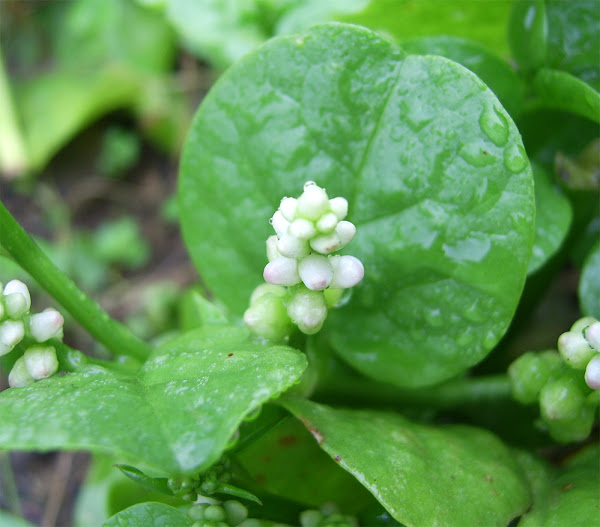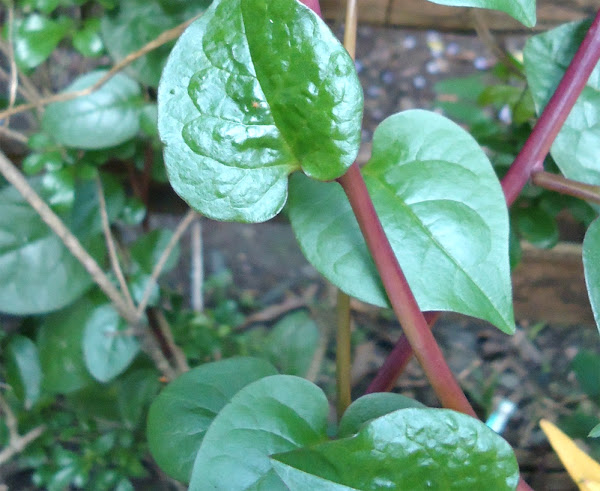Growing Malabar spinach is extremely easy, and it is found and widely grown in tropical Asia, and also found in Africa. It is native to the Indian Subcontinent, Southeast Asia and New Guinea.
But it is also found in many other different places around the world. The Malabar spinach is widely used as a leaf vegetable.
The Malabar spinach (Basella alba) is actually not a true spinach. It is actually an edible perennial vine in the family Baseliaceae. It is known and called by many different names in different parts of the world.
In India, it is known as pui shak in Bengali, bachhali in Telugu, basale in Tulu, kodip pasali in Tamil, vel niviti in Sinhalese, poi saaga in Odia. mayalu in Marathi, vallicheera in Malayalam, valchi bhaji or daento or vauchi bhaji in Konkani, basale soppu in Kannada, poi ni bhaji in Gujarati.
In East Asia the Malabar spinach is known as saan choy, xan choy, shan tsoi, luo kai, shu chieh and lo kwai in some of readings of Cantonese, and known as tsurumurasaki in Japanese.
And in Southeast Asia, it is known as mong toi in Vietnamese, pak plang in Thai, alugbati in Tagalog, libatu in Kapampangan and kubay in Ibanag.
In West Africa, the Malabar spinach is known as ‘Efo amunututu’ (especially, among the Yuraba tribe in South West Nigeria).
And in Latin America, it is known as Espinaca China (Chinese Spinach), espinaca de Malabar in Spanish, and bertalha or espinafre indiano in Portuguese.
But the common English names of the Malabar spinach include Ceylon spinach, buffalo spinach, creeping spinach, climbing spinach, red vine spinach, vine spinach, Indian spinach, Surinam spinach, Chinese spinach, Vietnamese spinach and broad bologi.
Whatever the name is, the Malabar spinach is typically used as a leaf vegetable in most of the areas where it is available.
It is very nutritious and very good for human health. It is high in vitamin A and C, iron and calcium. It is high in protein per calorie, but low in calories by volume. It is high in soluble fiber.
And this vegetable can be consumed in many different ways. It may also be used to thicken soups or stir-fries with garlic and chili peppers.
But the Malabar spinach is consumed mainly by cooking in many different ways. However, you can enjoy this great vegetable if you start growing Malabar spinach in your own home garden.
How to Grow Malabar Spinach
Growing Malabar spinach is extremely easy. The plants grow well throughout the tropics, especially in moist lowlands.
It is mainly grown as an annual, but also grows like a perennial in regions that are frost free.
However, here we are describing more information about growing Malabar spinach in home garden from planting, caring to harvesting.

Select a Good Location
First of all, select a good location in your garden for growing Malabar spinach.
These plants generally grow best under full sun and in humid climates. Although, they will grow well under partial shade.
Prepare the Soil
The Malabar spinach grow well in a variety of soil conditions. But the plants prefer moist soil which is rich in plenty of organic materials.
Soil pH between 6.5 and 6.8 is considered best for growing Malabar spinach. Prepare the soil for growing Malabar spinach by tilling the soil and adding lots of organic materials into it.
Well-rotted aged manure and fully decomposed homemade compost will be good for using in the soil.
Choose a Variety
There are mainly two different varieties of Malabar spinach available namely ‘green and red’. The stem of the green variety is green, and red or reddish-purple in the red variety.
But the leaves are green in both varieties. You can actually choose any variety depending on it’s availability in your area.
You can also consult with an existing home gardener in your area for having good recommendation.
Purchase Seeds
The Malabar spinach plants are mainly grown from seeds (although, you can grow them from cuttings but it’s not recommended).
It is a very common vegetable, and the seeds should be easily available in your area. Visit any of your nearest nurseries, markets or garden centers for purchasing the seeds.
You can also consider ordering the seeds online. Because today there are many seed suppliers available with online stores.
Best Time for Growing Malabar Spinach
The Malabar spinach is a summer season crop, and grows best in the summer months in the tropical areas.
The plants can thrive in extreme hot temperatures. And cool temperatures cause the plants to creep. So, you should plan for growing Malabar spinach during the summer months.
Planting
The Malabar spinach plants can be grown from both seeds and cuttings. But growing Malabar spinach from cuttings is not recommended.
You should plant the seeds. After tilling the soil and adding organic materials into it, level the soil and mark several rows.
You should sow the seeds when the soil is warm enough. Because the seeds will not germinate faster if the soil is cool. You can start the seeds indoor earlier and transplant later.
Keep the rows to about 1.5-2 ft apart, and space the plants to about 1-1.5 ft apart. Soak the seeds in clear water for 24 hours before sowing. Under good condition, the seeds should germinate within a week.
Caring
The Malabar spinach plants will grow well if the weather is warm and the soil is moist. They generally don’t require much care.
But taking additional care will help the plants to grow better. Here we are describing more about additional caring for growing Malabar spinach plants.

Fertilizing: You don’t have to provide additional fertilizers if you have already prepared the soil by adding lots of organic materials into it.
Watering: Regular watering is a must for growing Malabar spinach. The Malabar spinach plants grow well in moist soil. So keeping the soil moist constantly is very important for preventing the blossoming, which will turn the leaves bitter. As the plants grow in the summer months, so regular watering is a must for them.
Mulching and Controlling Weeds: Mulch the Malabar spinach bed with organic materials. Mulching not only helps to retain moisture into the soil but also helps to keep the garden free from weeds. Use straw, grass clippings, hay or homemade compost as mulch.
Trellis or Support: The Malabar spinach plants are vigorous climbers which require a trellis or other type of support.
Pests and Diseases
Diseases are less in the Malabar spinach plants. But some pests can harm the plants. Use organic insecticides for controlling pests.
Harvesting
The Malabar spinach leaves will be ready to harvest when the plants have enough leaves. Just clip the leaves when you need them in the kitchen. The young leaves are much tastier than the older leaves.
Taste of the Malabar spinach is a cross between spinach and chard, when lightly steamed or stir-fried.
These are the common steps for growing Malabar spinach in home garden. Hope you have enjoyed this guide! Happy gardening 🙂






